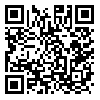Volume 7, Issue 3 (September 2025)
IEEPJ 2025, 7(3): 0-0 |
Back to browse issues page
Download citation:
BibTeX | RIS | EndNote | Medlars | ProCite | Reference Manager | RefWorks
Send citation to:



BibTeX | RIS | EndNote | Medlars | ProCite | Reference Manager | RefWorks
Send citation to:
Gohari H, Taheri A, Sabet M. (2025). Structural Equation Modeling of Drug Use Tendencies Based on Emotional Reactivity and Self-Criticism Levels: Mediating Role of Rumination. IEEPJ. 7(3),
URL: http://ieepj.hormozgan.ac.ir/article-1-1023-en.html
URL: http://ieepj.hormozgan.ac.ir/article-1-1023-en.html
1- PhD Student in Clinical Psychology, Department of Psychology, Roudehen Branch, Islamic Azad University, Tehran, Iran.
2- Assistant Professor, Department of Psychology, Roudehen Branch, Islamic Azad University, Tehran, Iran ,A2_taheri@yahoo.com
3- Associate Professor and Faculty Member, Department of Psychology, Roudehen Branch, Islamic Azad University, Roudehen, Iran
2- Assistant Professor, Department of Psychology, Roudehen Branch, Islamic Azad University, Tehran, Iran ,
3- Associate Professor and Faculty Member, Department of Psychology, Roudehen Branch, Islamic Azad University, Roudehen, Iran
Abstract: (429 Views)
Objective: This study aimed to develop a structural equation model to predict drug use tendency based on emotional reactivity and self-criticism, with the mediating role of rumination.
Methods: The research employed a descriptive–correlational design using path analysis. The statistical population included all individuals who attended the Bani Nik Substance Abuse Center during the first six months of 2024. Using convenience sampling and accounting for potential attrition, 250 eligible participants were selected. Data were collected using the Emotional Reactivity Questionnaire, the Self-Criticism Scale, the Rumination Scale, and the Addiction Tendency Questionnaire. Descriptive statistics were calculated, normality was assessed with the Smirnov test, and Pearson correlations were analyzed in SPSS v.24. Path analysis with AMOS and the bootstrap test were applied to examine mediating effects.
Results: The proposed structural model demonstrated acceptable fit indices. Direct effects of both emotional reactivity and self-criticism on drug use tendency were significant. Moreover, rumination played a mediating role: higher levels of emotional reactivity and self-criticism increased rumination, which in turn elevated drug use tendency. These findings highlight rumination as a critical pathway linking individual vulnerabilities to substance use behaviors.
Conclusions: The study underscores the dual direct and indirect roles of emotional reactivity and self-criticism in shaping susceptibility to drug use. Addressing maladaptive rumination, alongside managing emotional reactivity and self-critical tendencies, may serve as an effective preventive and therapeutic approach in substance use interventions.
Methods: The research employed a descriptive–correlational design using path analysis. The statistical population included all individuals who attended the Bani Nik Substance Abuse Center during the first six months of 2024. Using convenience sampling and accounting for potential attrition, 250 eligible participants were selected. Data were collected using the Emotional Reactivity Questionnaire, the Self-Criticism Scale, the Rumination Scale, and the Addiction Tendency Questionnaire. Descriptive statistics were calculated, normality was assessed with the Smirnov test, and Pearson correlations were analyzed in SPSS v.24. Path analysis with AMOS and the bootstrap test were applied to examine mediating effects.
Results: The proposed structural model demonstrated acceptable fit indices. Direct effects of both emotional reactivity and self-criticism on drug use tendency were significant. Moreover, rumination played a mediating role: higher levels of emotional reactivity and self-criticism increased rumination, which in turn elevated drug use tendency. These findings highlight rumination as a critical pathway linking individual vulnerabilities to substance use behaviors.
Conclusions: The study underscores the dual direct and indirect roles of emotional reactivity and self-criticism in shaping susceptibility to drug use. Addressing maladaptive rumination, alongside managing emotional reactivity and self-critical tendencies, may serve as an effective preventive and therapeutic approach in substance use interventions.
Type of Study: Original |
Subject:
Educational Psychology
Received: 2025/03/25 | Accepted: 2025/05/23 | Published: 2025/09/1
Received: 2025/03/25 | Accepted: 2025/05/23 | Published: 2025/09/1
Send email to the article author
| Rights and permissions | |
 |
This work is licensed under a Creative Commons Attribution-NonCommercial 4.0 International License. |






